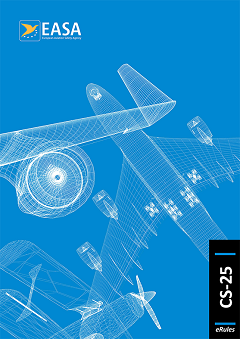ED Decision 2005/006/R
The air intake system for the APU:
(a) Must supply the air required by the APU under each operating condition for which certification is requested,
(b) May not draw air from within the APU compartment or other compartments unless the inlet is isolated from the APU accessories and power section by a firewall,
(c) Must have means to prevent hazardous quantities of fuel leakage or overflow from drains, vents, or other components of flammable fluid systems from entering,
(d) Must be designed to prevent water or slush on the runway, taxiway, or other airport operating surface from being directed into the air intake system in hazardous quantities,
(e) Must be located or protected so as to minimise the ingestion of foreign matter during takeoff, landing, and taxiing.
[Amdt 25/1]
CS 25J1093 Air intake system icing protection
ED Decision 2016/010/R
(See AMC 25J1093)
(a) Each non-essential APU air intake system, including any screen if used, which does not comply with CS 25J1093(b) will be restricted to use in non-icing conditions, unless it can be shown that the APU complete with air intake system, if subjected to the icing conditions, defined in Appendices C, O and P will not affect the safe operation of the aeroplane.
b) For essential APUs:
Each essential APU, with all icing protection systems operating, and screen if used, must:
(1) operate throughout its flight power range in the icing conditions defined in Appendices C, O and P, and in falling and blowing snow within the limitations established for the aeroplane for such operation, without the accumulation of ice on the APU, air intake system components or airframe components that would do any of the following:
(i) Adversely affect installed APU operation or cause a sustained loss of power; or an unacceptable increase in gas path operating temperature; or an airframe/APU incompatibility; or
(ii) Result in unacceptable temporary power loss or APU damage; or
(iii) Cause a stall, surge, or flameout or loss of APU controllability (for example, rollback).
(2) operate for a minimum of 30 minutes on the ground in the icing conditions shown in Table 1 of CS 25.1093(b)(2), unless replaced by similar test conditions that are more critical. These conditions must be demonstrated with the available icing protection (if applicable) at its critical condition, without adverse effect. The applicant must document the APU minimum ambient temperature demonstrated, if any, and establish the aeroplane operating limitations. (See AMC 25J1093(b))
[Amdt 25/1]
[Amdt 25/16]
[Amdt 25/18]
AMC 25J1093(b) Essential APU air intake system de-icing and anti-icing provisions
ED Decision 2015/008/R
1. General
In establishing compliance with the requirements of CS 25J1093(b), reference should be made to AMC 25.1093(b). All the reference made to “engine” may be transposed to “essential APU”. Engine test (especially CS-E 780) may refer to essential APU icing test done for the APU certification, if any.
When the air intake is assessed separately, it should be shown that the effects of air intake icing would not invalidate the icing tests of CS-APU. Factors to be considered in such evaluation are:
a. Distortion of the airflow and partial blockage of the air intake.
b. The shedding into the APU of air intake ice of a size greater than the APU has been shown to ingest.
c. The icing of any APU sensing devices, other subsidiary air intakes or equipment contained within the air intake.
d. The time required to bring the protective system into full operation
2. Operating limitations
The conditions defined in CS 25J1093(b)(2), in terms of time and temperature, should be considered as limitations necessary for the safe operation in freezing fog, and made available to the crew in the Aeroplane Flight Manual (refer to CS 25.1581).
Nevertheless, the applicant may use an analysis to substantiate safe operation of the APU at temperatures below the demonstrated minimum temperature. No limitation would then be required in the Aeroplane Flight Manual.
Any additional substantiation provided by the applicant to demonstrate the capability of an extended exposure beyond the conditions defined in CS 25J1093(b)(2), based on further testing and/or analysis, will be considered by the Agency.
[Amdt 25/1]
[Amdt 25/16]
CS 25J1103 Air intake system ducts
ED Decision 2005/006/R
(a) Each air intake system duct must be:
(1) Drained to prevent accumulation of hazardous quantities of flammable fluid and moisture in the ground attitude. The drain(s) must not discharge in locations that might cause a fire hazard; and
(2) Constructed of materials that will not absorb or trap sufficient quantities of flammable fluids such as to create a fire hazard.
(b) Each duct must be:
(1) Designed to prevent air intake system failures resulting from reverse flow, APU surging, or inlet door closure; and
(2) Fireproof within the APU compartment and for a sufficient distance upstream of the APU compartment to prevent hot gases reverse flow from burning through the APU air intake system ducts and entering any other compartment or area of the aeroplane in which a hazard would be created resulting from the entry of hot gases.
The materials used to form the remainder of the air intake system duct and plenum chamber of the APU must be capable of resisting the maximum heat conditions likely to occur.
(c) Each duct connected to components between which relative motion could exist must have means for flexibility.
[Amdt 25/1]
CS 25J1106 Bleed air duct systems
ED Decision 2005/006/R
(a) For APU bleed air duct systems, no hazard may result if a duct failure occurs at any point between the air duct source and the aeroplane unit served by the bleed air.
(b) Each duct connected to components between which relative motion could exist must have a means for flexibility.
(c) Where the airflow delivery from the APU and main engine is delivered to a common manifold system, precautions must be taken to minimise the possibility of a hazardous condition due to reverse airflow through the APU resulting from malfunctions of any component in the system.
[Amdt 25/1]
